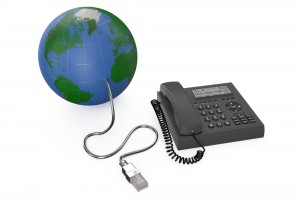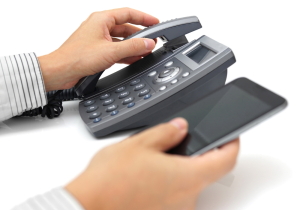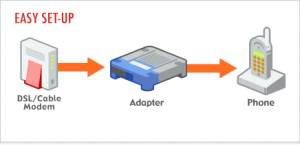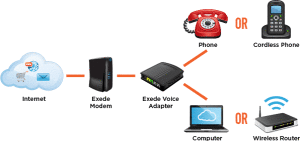What Businesses Can Expect with Voice over Mobile Broadband
 Technology is advancing at a steady rate, constantly changing the way businesses and individuals communicate in today’s marketplace. Formerly, switching from a legacy network to Voice over Internet Protocol (VoIP) lowered the costs and reduced the delays associated with long-distance calling, which enabled greater global outreach.
Technology is advancing at a steady rate, constantly changing the way businesses and individuals communicate in today’s marketplace. Formerly, switching from a legacy network to Voice over Internet Protocol (VoIP) lowered the costs and reduced the delays associated with long-distance calling, which enabled greater global outreach.
Currently, the need for faster connections and more bandwidth has spurred the increased adoption of Voice over Long Term Evolution (VoLTE) networks. However, the next big change in business communication will involve Voice over Mobile Broadband (VoMBB), and knowing what to expect can help companies make the transition.
VoMBB Basics
VoMBB is essentially the process of connecting cellular calls over mobile broadband networks like LTE and WiFi. As more businesses continue to deploy cost-saving flexibility through remote work stations and an enlarged mobile workforce, broadband requirements have increased.
However, since massive, commercialized LTE networks are widespread, VoMBB will utilize that availability to escalate the speed and quality of voice and data transmissions, offering enhanced services for a variety of organizations.
Security Concerns
Maintaining data protection is always a top priority. Although utilizing a public network to transmit voice data involves heightened risks, security concerns will be addressed as they were for VoIP. Encryption and authentication support provided by Session Initiation Protocol (SIP) and H.323 protocols will offer businesses the cost benefits of VoMBB with familiar methods of protection.
Over-the-Top Apps
To combat the lag time created by over-the-top (OTT) apps like Skype, VoMBB providers will need to develop relationships with OTT app developers. This change will also provide an opportunity for businesses. Mobile carriers will be able to structure voice and data transmission costs according to specific usages, which will provide businesses with enhanced regulation metrics. By monitoring this type of data transfer, improved efficiency and cost controls can be enacted.
Cloud Options
In addition to the internal controls that companies can develop by using VoMBB, providers will be able to utilize cloud resources for immediate activation. With voice over WiFi, providers are able to offer the VoLTE infrastructure required now, and then support high-speed packet access later. This lowers costs and delivers the mobility needed by today’s businesses.
As mobile workplaces expand and the number of users who need instant remote access to business information grows, changes in the way voice data is transmitted will continue to evolve. VoMBB will offer faster connections and greater bandwidth agility through the cloud, allowing providers to lower the costs and improve service capabilities. Businesses will reap the benefits of heightened capacity and mobilized solutions that enlarge profits and support growth.
Don’t Write off a Business Phone System Just Yet
 Thanks to technology, land lines have disappeared across much of America. This trend began in the residential space and was quickly followed by businesses abandoning their traditional telephone services. Voice over IP (VoIP) has swooped in as their state-of-the-art replacement, boasting customer relationship management (CRM) integration tools, automated routing, call handling, and sophisticated reporting and monitoring functions. Phone systems have come a long way, and they now serve many more purposes than just making calls. Before making the decision to abandon the company phone system, consider the following points.
Thanks to technology, land lines have disappeared across much of America. This trend began in the residential space and was quickly followed by businesses abandoning their traditional telephone services. Voice over IP (VoIP) has swooped in as their state-of-the-art replacement, boasting customer relationship management (CRM) integration tools, automated routing, call handling, and sophisticated reporting and monitoring functions. Phone systems have come a long way, and they now serve many more purposes than just making calls. Before making the decision to abandon the company phone system, consider the following points.
Phone Systems and Customer Service
Thanks to the Internet, collaboration tools have never been more plentiful. Free conference calling, webinars, video chat, IM, and other online communications tools make the world a much smaller place and allow geographically dispersed teams to communicate as if they are only cubicles away.
Since there are so many available software options for communication, it’s easy to see how compatibility problems can arise. Utilizing different pieces of software may work for staff members, but that won’t always be the case when working with clients. Even for tech-savvy customers, it always seems like a plugin, system update, or forgotten password is in the way of getting urgent help. Less technically inclined customers may become so frustrated that they take their business elsewhere. In contrast, using a VoIP phone system is an easy way to support customers and provide them with the excellent service they demand.
The Benefits of an Inbound Phone Line
A business may not need to make outbound phone calls, but providing an inbound phone line can be useful in several ways.
- Customer service is enhanced by providing voice-to-voice contact (which is a luxury today).
- Listing a personal cell phone number to handle business calls is not always desirable.
- Having a professional business phone line generates trust and provides accessibility to quality customer service, which can be a differentiator in a congested marketplace.
Phone System ROI
One of the chief complaints about phone systems is the significant expense to acquire, maintain, and add to them. Fortunately, VoIP has made calling very inexpensive (down to a few pennies per minute), and plans can be tailored to a business’s expected volume. Whether personnel need to make one or one hundred calls per day, there is a plan on the market to fit that requirement. Many phone system plans also allow intracompany calling for free using Session Initiation Protocol (SIP) trunking.
For a reasonable cost, a company can have a sophisticated phone system with many valuable problem-solving features. Even better, hosted systems may perform all functions through software, with no expensive phone equipment needed. With increased customer loyalty and company growth, the ROI could be exponential.
Forgoing a phone system may save money in the short term, but ultimately it can be an expensive decision. VoIP systems are a great way to provide the communications staple needed for customer convenience while keeping the bill and equipment affordable. Before walking away from a potentially effective solution, research the available plans. The affordability and flexibility of today’s options make them well worth consideration.
3 Things to Consider When Choosing a VoIP System
 More businesses are adopting Voice over Internet Protocol (VoIP) solutions than ever before. From streamlined platforms to centralized communications, VoIP is a truly cost-effective and flexible alternative to outdated phone systems. VoIP improves operational efficiency, cuts telecommunication costs, and increases overall performance. The preferred choice for countless brands and ventures, VoIP easily integrates into any existing telephony system or communications protocol.
More businesses are adopting Voice over Internet Protocol (VoIP) solutions than ever before. From streamlined platforms to centralized communications, VoIP is a truly cost-effective and flexible alternative to outdated phone systems. VoIP improves operational efficiency, cuts telecommunication costs, and increases overall performance. The preferred choice for countless brands and ventures, VoIP easily integrates into any existing telephony system or communications protocol.
Within the VoIP market, however, there are several brands and services available. The only way to secure the best VoIP package is to conduct extensive research. When it comes to the right system for your business, there are three important aspects to consider.
Scalability
Scalability should be of paramount concern when selecting a VoIP system. Companies should look for the following before choosing a service provider:
- affordable VoIP services that promote brand growth and expansion;
- seamless integration of VoIP into existing telephony and business communications platforms;
- file sharing, screen sharing, uploads, downloads, and any other specific features that are needed by the business;
- Session Initiation Protocol (SIP) trunking to expand or reduce business lines on an as-needed basis; and
- compatibility between private branch exchange (PBX) and SIP, with the flexibility to enhance, edit, or bring on new services.
Hosted vs. On-site Services
There are hosted and on-site options available for PBX services. Both have their unique advantages and disadvantages and should be taken into consideration when adopting new VoIP platforms.
Hosted PBX
- Businesses without existing PBX hardware tend to benefit from cloud-hosting services.
- Cloud services are easier to deploy, are more cost-efficient, and eliminate the need to purchase new hardware and pay maintenance fees.
On-site PBX
- On-site systems offer more flexibility and better control over private telecommunications networks.
- On-site PBX is the best option for companies that have the means to invest in hardware and maintenance for optimal system functionality.
Deciding between on-site and remote services depends on the particular needs of the company. Businesses should also weigh the benefits and risks of deploying these services before signing their names on the dotted line.
Workforce Mobility
With the advent of burgeoning technologies and bring your own device (BYOD) policies, more and more employees are able to get work done while on the go. In fact, many now use their own mobile, wireless, and digital devices from remote venues. With this in mind, businesses need to integrate contact lists, video conferencing, and call-forwarding services for their remote teams.
With modern VoIP features, businesses are also able to secure more freedom and flexibility for workers. They no longer have to invest in expensive tools for mobile workforces, since the same applications and programs are being utilized across the board.
SIP Trunking or Hosted PBX: Telephony Planning for a Growing Business
 Every growing enterprise faces choices about the best telephony solution to meet its needs. Session Initiation Protocol (SIP) trunking or a hosted private branch exchange (PBX) are both viable solutions, but a business must determine which is more suited to its particular requirements.
Every growing enterprise faces choices about the best telephony solution to meet its needs. Session Initiation Protocol (SIP) trunking or a hosted private branch exchange (PBX) are both viable solutions, but a business must determine which is more suited to its particular requirements.
Exploring the Similarities and Differences Between SIP Trunking and Hosted PBX
At first glance, SIP trunking and hosted PBX seem very similar. Both are IP-based systems and offer the same basic services such as:
• streaming audio and video;
• VoIP telephone connections to include local, long distance, and toll-free lines;
• support of both mobile and fixed phone systems; and
• support of data transmission for email, fax, text messages, and Internet access.
However, one of the primary differences between the two is that a SIP trunking system requires fixed assets and support, whereas hosted PBX does not.
Hosted PBX is generally a service provided by a vendor that requires neither an investment in equipment nor staff to oversee the system. This is a lower cost solution, but it is completely dependent on a third party for the operation of a vital business asset.
A SIP trunking solution requires an initial investment in expensive equipment and infrastructure as well as the ongoing cost of maintenance and service professionals. But despite these costs, this investment can lead to long-term flexibility and room for growth.
Size Matters
Smaller businesses will often benefit more from hosted PBX. Essentially an all-in-one telecommunications provider, the hosted PBX vendor delivers a hands-free telephone system that meets a small business’s needs without the cost of equipment and dedicated staff. Additionally, because hosted PBX is cloud-based, a small business has the option to switch providers without any significant interruption of service.
But as a business grows, it often needs much greater use of bandwidth and therefore requires more resources. A hosted PBX service can be expanded to compensate for the greater needs of a larger business, but this is usually accomplished at a higher cost. Eventually, there comes a point in a business’s growth when it becomes more efficient to opt for a SIP trunking solution.
A larger business with a SIP Trunking solution is able to manage its critical telecommunications system in-house and does not have to rely on an external supplier. This affords the business a level of self-reliance and allows for more overall bandwidth as well as room for growth.
Looking Ahead
Ultimately, it seems that both SIP trunking and hosted PBX systems have a future in enterprise telephony. Both systems are well suited to a particular clientele and have enough overlap in customer base to allow for healthy competition. Choosing between SIP trunking or hosted PBX is a matter of analyzing a business’s current and long-term needs.
The Ever-Evolving VoIP
 The birth cry of the Internet came about in the U.S. when the Advanced Research Projects Agency Network (ARPANET) delivered the first data packet between two computers in 1969. That very same ARPANET saw the birth of Voice over Internet Protocol (VoIP) when the first data packet of encoded voice was transmitted in 1974. In recent years, the dawning and proliferation of the information age has seen VoIP truly come into its own.
The birth cry of the Internet came about in the U.S. when the Advanced Research Projects Agency Network (ARPANET) delivered the first data packet between two computers in 1969. That very same ARPANET saw the birth of Voice over Internet Protocol (VoIP) when the first data packet of encoded voice was transmitted in 1974. In recent years, the dawning and proliferation of the information age has seen VoIP truly come into its own.
An Innovation in the Data World
From businesses to the home internet connection, relatively inexpensive high speed internet is allowing VoIP to replace traditional telephone services. In all but the most remote rural areas, sufficient internet speeds are now available, prompting consumers to question the need for both telephone and internet services when internet will serve both voice and data functions.
Affordability and Convenience
In the past there has been resistance to innovations such as VoIP due to cost and the dread of having to get a new telephone number. That is no longer the case. VoIP equipment is highly affordable and often is less costly than even an average smartphone. Further, the cost of transmitting a data packet over long distance is hardly more than the cost to send the same data packet across the room, making VoIP more affordable than traditional long distance telephone services.
In the early days, a VoIP call had to go through a third party because telecommunications companies held a certain level of propriety over the connections. Now, VoIP calls go directly to the recipient, bypassing the middleman and keeping costs low.
Changes in FCC laws now allow phone numbers to be transferred from one service to another. The process of making the change takes just moments, and the service provider is usually happy to do the work in order to get new business. The service itself is has yearly costs comparable to regular monthly cellular phone charges.
Services That Are Part of the Package
Most VoIP packages include long distance as just another service provided for a very low single fee if not provided entirely for free. A number of services once considered to be extras were billed as such but are now being provided by VoIP as a standard package. Some of these standard services provided at little to no additional cost include call forwarding, voicemail, and call waiting.
Marrying VoIP to Apps
VoIP is IP-based and highly adaptable with regard to data handling applications. As a result, VoIP telephony systems are capable of previously unheard of functions and new applications are arriving on the scene every day. From screen sharing to faxing to email, the IP-based world is growing and expanding in capabilities at a mind-boggling rate. With the affordability of VoIP services being realized, what was once thought to be a tool for businesses has taken root in the home.
VoIP vs PBX: The Benefits and Disadvantages
 With more available options for communications, many businesses are looking at what service they should use for their telephone line: a more traditional Private Branch Exchange (PBX) or the newer Voice over IP (VoIP).
With more available options for communications, many businesses are looking at what service they should use for their telephone line: a more traditional Private Branch Exchange (PBX) or the newer Voice over IP (VoIP).
Both services have their advantages and disadvantages, including cost and reliability. PBX may be an easier option for internal employees, because it allows businesses to connect all their internal phone lines to a single leased external phone line. In most cases, this means that employees would only need to dial an extension number rather than dialing the full number to call a coworker.
VoIP, on the other hand, uses the Internet to make phone calls by transferring audio information as digital data. It possesses many of the same benefits as a PBX, but it has a lower cost. However, there are also some disadvantages to a VoIP system, leading some businesses to consider an IP PBX system, a combination of the two.
Cost
For large businesses or those that are geographically dispersed, cost may be the single biggest factor in whether to choose PBX or VoIP.
Using a PBX system comes with a monthly charge that can fluctuate depending on how many phone calls are made. In addition, whether or not these calls are made internationally can increase the price. However, VoIP systems use the company’s broadband connection to place phone calls, meaning that the majority of the calls are free no matter where in the world the person is calling. Another benefit of VoIP is a low initial cost; instead of an entirely new system, businesses only need to purchase phone adapters that will change their system from analogue to digital.
Reliability
While cost is lower for VoIP, its reliability can sometimes come into question when compared with a PBX system. Because VoIP relies on the company’s Internet connection, loss of power or connection means that phones will also be unavailable. In contrast, PBX systems are powered by the telephone wire itself and will still work even if the power is out. Some businesses are looking into an IP PBX system for this reason: The ease and cost of a VoIP system with a few PBX lines is ideal for emergencies.
Quality
The company’s Internet connection will also affect the quality of phone calls made over VoIP. Small companies with slow or low-capacity Internet will find that voice quality is lower than with PBX. Fortunately, there are many features in a VoIP system—such as the ability to access a work phone number no matter a person’s physical location—that will encourage businesses to upgrade to a more robust Internet connection.
IT professionals and business leaders should have a good understanding of the pros and cons of VoIP and PBX before deciding which one to purchase. While cost is lower for VoIP, PBX has the advantage in reliability and will still work even without power or an Internet connection. However, with the speed with which today’s digital world moves, businesses may find that VoIP allows them the mobility to keep up – with PBX lines as a backup.
Predicting the Future of IP Phones: Will They Go Extinct?
 When talking about extinction, one tends to think of dinosaurs, the dodo, or maybe an endangered species such as the rhinoceros. So, when talking about technology that goes extinct, one might presume the ice box, the buggy whip, or maybe the rotary dial phone. One hardly thinks about VoIP (voice-over Internet protocol) phones as being relegated to the evolutionary trash can. Yet, that’s exactly what some online magazines and blogs are saying.
When talking about extinction, one tends to think of dinosaurs, the dodo, or maybe an endangered species such as the rhinoceros. So, when talking about technology that goes extinct, one might presume the ice box, the buggy whip, or maybe the rotary dial phone. One hardly thinks about VoIP (voice-over Internet protocol) phones as being relegated to the evolutionary trash can. Yet, that’s exactly what some online magazines and blogs are saying.
Crystal Balls Say Obsolescence?
Not too long ago, phone companies announced land lines and the current telephone system as being obsolete. In fact, many major phone companies are looking to switch to VoIP.
To predict that IP phones now will be rendered obsolete might seem a bit off-kilter. After all, there are still fax machines in offices, and people still have desk phones. It’s unlikely, it seems, that the IP phone will go the way of the dodo.
Purpose Built
SIP (session initiation protocol) and changing open standards have radically changed the IP phone industry.
No longer do businesses need to rely on proprietary technology. Because of this, the IP telephone is evolving to suit the needs of those who use it. Whether it’s a call center or the need for a rugged phone system in factories and warehouses, the IP phone has changed to suit the needs of the customer.
No New Window
One IP phone that is certain to stand the test of time is the type of IP phone that allows users to make and receive phone calls without having to open up a window on their computer. This IP phone allows the user to have all the conveniences of a desktop phone with all the benefits of using VoIP.
Simplicity Breeds Productivity
When looking for simplicity in a phone, think open source and fewer features. Fewer features allow the user to focus on doing the job, not on trying to learn a complex system. Like the above IP phones, many of these phones are not proprietary and will work with other open source software and equipment.
Keeping the IP phone simple makes it easier to use; thus, employees are more productive.
A Bright Future
No matter what the future holds for phone systems, it’s likely that IP phones will be there, thriving alongside new innovations and legacy systems.
As long as there is VoIP, there will be a need for something as flexible and familiar as IP phones. In addition, as the needs of clients continue to change, IP phones will continue to change along with those needs.
What Every Business Needs to Know: Toll Fraud & VoIP
 Toll fraud is a serious security threat for businesses that use VoIP (voice-over Internet protocol), which is especially susceptible to toll fraud. Besides being a type of fraud–which no business wants–toll fraud can cause serious financial damage for businesses.
Toll fraud is a serious security threat for businesses that use VoIP (voice-over Internet protocol), which is especially susceptible to toll fraud. Besides being a type of fraud–which no business wants–toll fraud can cause serious financial damage for businesses.
Yet, some business owners are not aware of what toll fraud is nor of the steps they should take to ensure that it doesn’t happen to their business.
What is Toll Fraud?
Toll fraud is the stealing of minutes from and the tacking on of outrageous charges to both conventional phone systems and VoIP.
In the past, with legacy switches, toll fraud was very lucrative, but it was harder to accomplish, because phone companies relied on switches, and there was no connection to the Internet. Now, hackers target business VoIP systems, which often have more lax security than company computers, and are able to cash in on the toll fraud schemes.
Why Toll Fraud?
Besides stealing minutes, hackers get a cut whenever they commit toll fraud. Toll fraud is big business in some smaller countries that have primitive phone systems with little or no usage. These phone companies charge outrageous rates because very few people use them. Hackers will break into a business’s phone system and use their VoIP to these select countries, racking up huge toll bills. The phone system makes its money from those toll charges, and the hackers get a cut.
Unfortunately, once a company falls victim to toll fraud, the business has little recourse but to pay for it. Most of the charges are paid to the terminating carrier in the country to where the phone calls were made.
Why is VoIP Vulnerable?
Because VoIP is easy to hack, hackers are quick to break into company telephony systems and commit toll fraud.
Even though the amount of money isn’t as big as it once was, the amount of money hackers can make, both for themselves and the countries that initiate the toll fraud schemes, is still sizable. Given that in 2014, the average cost of a VoIP attack was around $36,000, businesses need to be concerned about toll fraud, because most small businesses are unable to absorb that kind of hit.
Because businesses are likely to consider that now that they have VoIP, they simply get free calling and toll fraud shouldn’t concern them, businesses are more likely to become victims of toll fraud. Because toll fraud operates differently, it becomes all that more imperative for businesses to protect their VoIP systems.
Top 5 Ways to Secure Sensitive Information from VoIP Phone Hackers
 Managing business operations in today’s virtual environment is an ongoing challenge. As more and more customers rely on the global access created through internet options, Voice over Internet Protocol (VoIP) has become a standard technology for many companies due to its incredible features and cost-effective benefits. But the emergence of new technologies also often means an increase in new ways of criminal hacking. Though hackers cannot be prevented 100 percent of the time, companies can certainly neutralize the threat to a great extent.
Managing business operations in today’s virtual environment is an ongoing challenge. As more and more customers rely on the global access created through internet options, Voice over Internet Protocol (VoIP) has become a standard technology for many companies due to its incredible features and cost-effective benefits. But the emergence of new technologies also often means an increase in new ways of criminal hacking. Though hackers cannot be prevented 100 percent of the time, companies can certainly neutralize the threat to a great extent.
As so much sensitive information is transposed through Dual-tone Multi-frequency (DTMF) tones, a security breach over a VoIP system can spell disaster in more ways than one.
In fact, almost any business that performs operations through Time-division Multiplexing (TDM) and Internet Protocol (IP)-based voice frameworks through VoIP are susceptible to phone hackers (sometimes referred to as toll fraud). Not only are payments and financial information at risk, but confidential data collected from healthcare providers, engineering companies, and corporate structuring plans (like downsizing or mergers) are also in danger from phone hackers.
Why?
Simple. There is just no substitute for the cost-effective benefits of VoIP. And the eruption of VoIP usage has shown up on hacker radar because previously IP-based communication was centralized on local networks, which were typically protected from the public internet. However, that’s ancient history as more and more of VoIP traffic is routed through un-encrypted, public internet services by telephony providers.
It is hardly surprising, therefore, that there are many tools available now which make it simple, easy, and untraceable for hackers to infiltrate confidential phone conversations. Practically anyone with a little bit of tech savvy and basic research can start collecting and storing voice information from external IP networks overnight.
The Best Offense Is a Great Defense
Because of these increased risks, companies must rethink their supplier’s encryption protocols and safety measures. What may have been adequate when the VoIP was incorporated is most likely now out of date.
Here are the top five things to consider when questioning a VoIP supplier about the systems they have in place to combat phone-based cyber-crimes:
- Ask providers about their Session Initiation Protocol (SIP) trunking services. The system should feature automatic deactivation of any components that aren’t secure, as well as encryption capability for all calls.
- Companies that routinely record calls (a necessary quality control procedure for many businesses) must ensure that their telephony system conforms to ISO protection requirements outlined for storing sensitive information.
- For any payments conducted over the phone, companies must adhere to the Payment Card Industry Data Security Standards (PCI DSS). Also, it is vital that the VoIP provider allocates encrypted connections for payment data.
- Find out about Transport Layer Security (TLS) protocols. Protecting client/server applications from tampering or spying between transports is crucial for secure communications.
- Depending on the risk of remote access susceptibility, consider a Distributed Denial of Service (DDOS). This creates a direct access circuit that is only available for designated voice traffic.
The incredible cost benefits of VoIP through external IP networks are great. But knowing the heightened risk of phone hacking through open (or public) network VoIP can help companies prevent devastating breaches in data security by neutralizing the threat of confidential information from being intercepted.
Three Ways VoIP Systems Can Work for You
.
By now, most people are familiar with Voice Over Internet Protocol (VoIP) thanks to software programs like Skype and Google Voice. But how many of us know exactly how VoIP systems work, and what benefit they have for your personal and business needs?
What are VoIP Systems?
Most simply put, VoIP systems take analog signals and turn them into digital ones that can be sent over the Internet. This might not sound so amazing, but when you consider what you can do with it, it becomes pretty impressive. Instead of paying your phone company (analog) a large amount and then having to shell out on top of that for Internet (digital) as well, you can make calls through the Internet, saving yourself a lot of money. Here, we’ll take a look at three different ways you can use VoIP to your benefit.

Analog Telephone Adapter
An Analog Telephone Adapter, or ATA for short, is a device that connects your analog phone to a digital phone system- VoIP. All you do is plug your phone into the ATA with the regular telephone jack, plug the ATA into the wall for poewr, and computer via ethernet or USB, and you’re good to go. The ATA will take the analog signals from your phone, digitize them, and have you connected to VoIP faster than you can say. It’s an easy and basic way to keep the phone you’re familiar with, but get all the benefits of VoIP. This method is usually seen with individuals in their homes.
IP Phones
The next progression in VoIP is using an IP phone where your phone connects directly to VoIP without the need of an intermediary device. Usually, you’ll connect your phone to your router with an ethernet cable. By using an IP phone, you bypass the public switched telephone network (PSTN) directly, making calls over Wifi. One downside is that when your Wifi goes, so, too, does your ability to make calls, but Wifi stability has been increasing to the point where a Wifi outage is rare and usually only happens in power outages, such as those caused by storms or fallen trees.

Computer-to-Computer
This method is the easiest and most inexpensive way of using VoIP, and probably the most familiar, too. If you’ve ever Skyped with someone with both of using laptops, you’re already familiar with computer-to-computer VoIP. Essentially, computer-to-computer just takes a software program (like Skype) and connects you to VoIP either on the Internet or a Local Area Network (LAN). Other than paying your monthly Internet bill, the only other thing you need is a computer with audio input and output so you can hear and be heard. The only thing to watch out for is how much bandwidth you have- how much data can be sent per second. You can still use VoIP with a bandwidth of 50 kbps, but the quality isn’t going to be very great. For better quality, using 100 kbps or more is better. To put this in perspective, streaming a a movie on Netflix with the best audio and video experience calls for about 5 Mbps, so 100 kbps isn’t that much at all.
